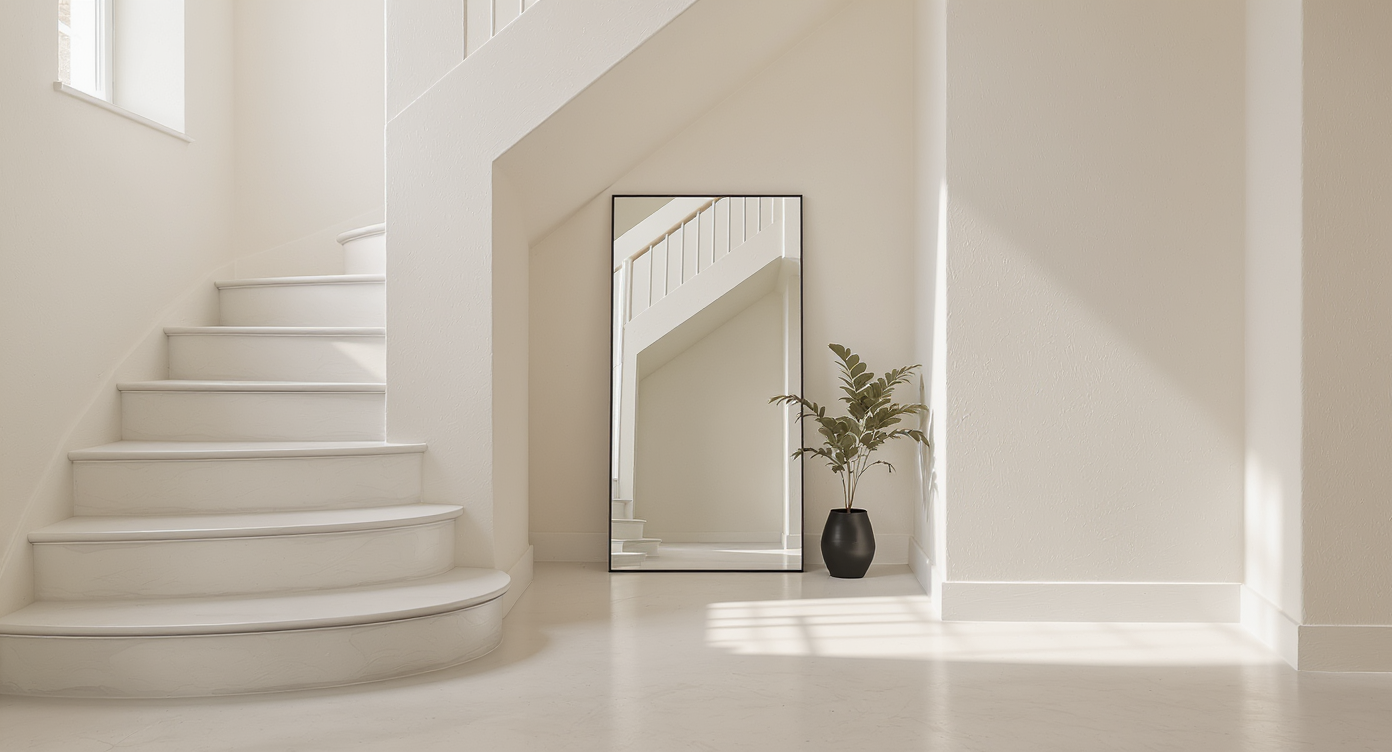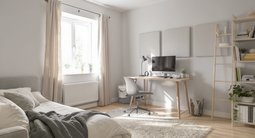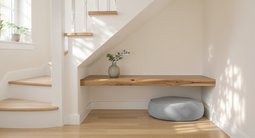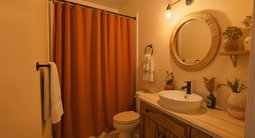TL;DR
Transform that awkward under-stairs space into a focal point — with plants, mirrors, or a pet nook — without blocking light or safety. You’ll learn how to decorate inaccessible space under stairs, what to plant in low light, and when to open the nook from the other side for storage. Low-touch, high-impact ideas fit small budgets and protect daylight.
Why this awkward nook matters

Visual vignette under open-riser stairs with mirror and plant creates calm ambiance while preserving daylight.
Under-stairs nooks with open risers are best treated as visual vignettes, not daily-use storage. When a space is hard to access, the goal is to preserve daylight and peace of mind while adding just enough personality.
Here’s the thing: budget, sustainability, and personalization are pushing DIY home décor toward restraint. People want calm, not clutter. I’ve seen homeowners try to wedge bookcases into tight angles, only to curse the dusting acrobatics a month later. The winning moves are low-maintenance and low-risk — ideas you can service from the stair edge in seconds.
So think of this nook less as square footage and more as a stage set. The right plants, a gleaming mirror, or a small pet lounge can make it sing without turning it into a tripping hazard.
A simple philosophy for staircase nooks
Designers often advise keeping 30–50 percent of tight architectural pockets as negative space to preserve daylight and sightlines. In short: less stuff, more breathing room.
That mindset links DIY home décor, budget decorating ideas, and small-space hacks with 2025 design trends. The shared philosophy is to create a clear focal point, control dust and moisture, and keep maintenance under five minutes per month. If it can’t be cleaned, watered, or adjusted from the bottom three steps, it doesn’t belong there. Think “edit, don’t cram,” and use simple materials — paint, plants, mirrors, and soft light — to do the heavy lifting.
Anecdote
A neighbor tried lining an under-stairs nook with tiny bookshelves; dusting required a step ladder and nerves of steel. Two months later, they swapped everything for one tall rubber plant on a pull-out tray — instantly calmer, instantly easier. A client later echoed the move, but from the opposite angle: they added a hidden door from the guest room, turning the void into a tidy seasonal closet while keeping the stair side beautifully open.
DIY hacks & tricks for hard-to-reach under-stairs space
If a space is hard to access, prioritize low-touch ideas that can be serviced from the stair edge in under five minutes. Choose elements that don’t block airflow, require minimal wiring, and won’t invite clutter.
01. The Let-It-Breathe Hero Plant
What it is: A single, sculptural plant or object that creates a quiet focal point while leaving negative space around it.
How it works: One statement item keeps the nook useful as a light well. A 60/30/10 balance is a helpful rule of thumb: 60 percent negative space, 30 percent focal object, 10 percent accent (like a low tray). Place foliage at least 8 inches away from stair treads and traffic edges. Choose a slow-growing, low-shed variety in a weighted pot with a saucer you can slide out. Experts recommend neutral pots to keep attention on form, not color.
How to try it:
- Pick a ZZ plant, sansevieria, or parlor palm for low light.
- Use a 12–16 inch self-watering planter with a hidden saucer.
- Style a small stone or book stack as a 10 percent accent.
02. Plantscape With Hidden Watering
What it is: A grouped trio of low-light plants arranged at increasing heights for depth and texture.
How it works: Group plants in odd numbers and vary leaf shape for dimension. Maintain 5–10 foot-candles for low-light species; if needed, add a low-heat 3000K grow bulb aimed from the side, not overhead. Watering should be hands-off: set all pots on a single waterproof tray you can pull forward from the bottom step. Capillary mats inside the tray let soil sip slowly, which reduces spills. Designers often advise rotating pots quarterly to balance growth toward the window.
How to try it:
- Place a 24–30 inch-long boot tray lined with capillary matting.
- Mix textures: one fern, one rubber plant, one trailing pothos.
- Add a timer outlet for a 6–8 hour/day side light if needed.
03. Mirror + Light Bounce
What it is: A tall mirror angled to catch the window and a soft uplight to brighten the void without harsh glare.
How it works: Mirrors amplify daylight and make narrow zones feel wider. Angle the mirror 10–15 degrees to reflect the brightest part of the window while avoiding direct line-of-sight glare from the stairs. Anchor the mirror to studs and keep a 2-inch gap from treads. Add a low-watt LED uplight at 2700–3000K to graze the underside of the stringer; this creates a soft wash that defines architecture without showing dust.
How to try it:
- Choose a shatter-resistant or safety-filmed mirror and anchor it.
- Use a plug-in uplight with a foot switch at the stair base.
- Consider a slim console ledge to hold matches, a candle, or keys.
04. The Under-Stairs Pet Lounge
What it is: A small, cozy corner for a cat or small dog with wall-mounted perches and a washable bed.
How it works: Build in from the side walls, not the floor void under the treads. A 12 by 18 inch bed suits most small pets; keep all elements at least 18 inches from the stair edge for safety. Felt or cork-backed shelves reduce noise and slipping. A lidded bin for litter or kibble can sit behind a curtain panel that matches the wall color. Experts recommend adding a battery motion light under 50 lumens for night comfort.
How to try it:
- Mount 2–3 perches into studs with 16-inch spacing.
- Choose washable textiles and a waterproof under-mat.
- Add a framed photo or tag to personalize the nook.
05. Open It From the Other Side
What it is: A structural-smart move: create an access door from the adjacent room so the nook becomes a closet, reading alcove, or seasonal storage.
How it works: This preserves the open look while reclaiming function. Many stair walls are framed 16 inches on center; an engineer or qualified contractor should verify loads before any cut. A 24–30 inch-wide door or panel from the adjoining room makes the space actually usable. Inside, line the cavity with moisture-resistant drywall and add LED strip lighting. Designers often advise a 1-inch threshold lip to contain dust.
How to try it:
- Confirm structure and utilities; never cut before you know what’s inside.
- Specify a flush, paint-matched door for a seamless look.
- Use labeled bins; keep the front 12 inches clear for airflow.
The thread that ties these ideas together
Resourceful design pairs low maintenance with high mood impact. The best under-stairs ideas give you a vibe every day and a chore list almost never.
I’ve seen a couple turn their nook into a rotating seasonal diorama — winter village one quarter, desert stones the next — all staged on a single pull-out tray for easy cleaning. Another homeowner tried a hanging mobile under the stringer; it swayed gently in the HVAC draft and became the most remarked-on feature during dinner parties. What ties these ideas together isn’t just frugality; it’s intention. Every choice preserves light, reduces trip risk, and favors materials you can manage from the last two steps.
Visualize before you DIY
Previewing layouts digitally reduces redo risk and material waste. A quick mockup will show you how plants, mirrors, or a pet lounge affect light and sightlines before you commit.
Upload a photo of your staircase to ReimagineHome and test variations: a single hero plant, a mirror-and-uplight combo, or a pet nook with wall perches. Swap planter sizes, tweak color temperature, and angle mirrors virtually until the composition clicks. When you can pre-visualize textures and lighting, you buy fewer materials — and every choice feels intentional.
Visualization Scenario
Snap your staircase on a bright afternoon, upload to ReimagineHome, and test two options side-by-side: a hero-plant vignette vs. a mirror-and-uplight combo. Toggle planter sizes, mirror angles, and bulb warmth until the daylight feels balanced; save the favorite render and shop with confidence.
FAQ: People also ask
- How should I decorate the space under my stairs if it’s hard to reach?
Use low-touch ideas like a single sculptural plant, a mirror with an uplight, or a pet nook you can service from the stair edge in minutes. - What plants work under stairs with indirect light?
ZZ plant, sansevieria, parlor palm, and pothos tolerate 5–10 foot-candles; supplement with a 3000K side light if natural light is weak. - Can I open the under-stairs space from the other side?
Yes, if structure allows. Experts recommend verifying loads, utilities, and framing, then adding a 24–30 inch access door from the adjoining room. - How do you keep an under-stair nook safe and easy to clean?
Maintain 30–50 percent negative space, anchor tall elements, use pull-out trays or mats, and avoid anything that requires climbing into the void. - What’s the best way to bounce natural light under stairs?
Angle a tall mirror 10–15 degrees to reflect the brightest window area and add a 2700–3000K uplight to graze architectural surfaces. - Is it okay to leave the under-stairs space empty?
Absolutely. Designers often advise leaving tricky niches open to preserve sightlines and daylight; empty can be a deliberate, elegant choice.
Leave room for light — and for life
Good design knows when to edit. In tight, under-stairs pockets, the winning move is to protect light and safety while introducing one clear, calming idea. Whether that’s a single plant, a mirror that doubles daylight, a gentle pet lounge, or a smart door from the room next door, the result should look effortless and stay easy to maintain.
If you’re unsure where to start, experiment digitally. Upload your space to ReimagineHome, try these layouts, and let the best version reveal itself — before you lift a brush, drill a hole, or water a leaf.
.svg)

.svg)









.png)